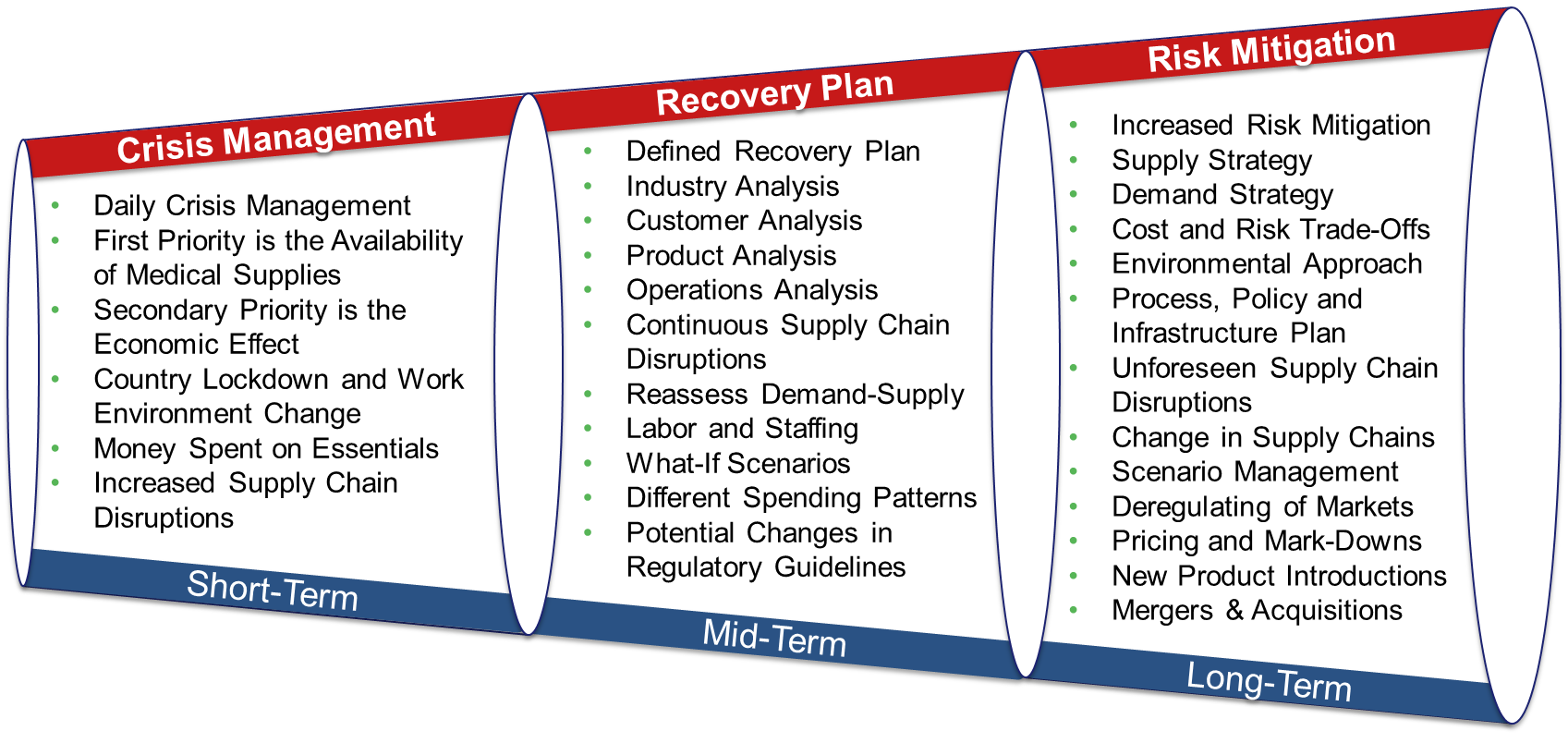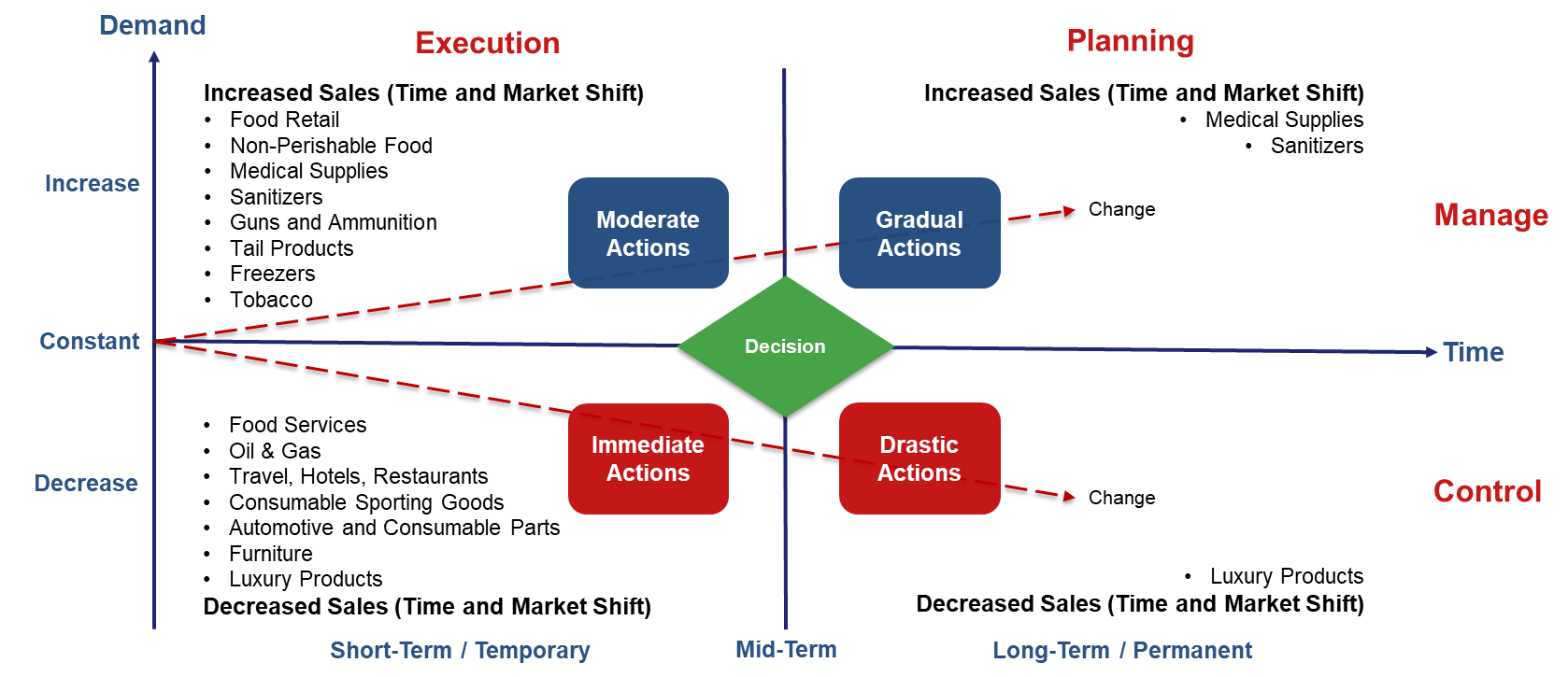The outbreak of the coronavirus has transformed global supply chains. For years, companies sought the most cost-effective suppliers with little regard for a supply disruption from that supplier. Now many countries, businesses and consumers are discovering how dependent they are on global supply chains, and how irrelevant negotiated incentives and penalties are when global markets, especially foreign ones, are challenged to serve their needs.
The business impact is tremendous and corporate changes are necessary to cope with the current supply chain challenges. Many companies are scrambling to establish approaches to respond to the current crisis, depending on the efficacy of their products in the different time horizons. While many companies are focusing on crisis management (short-term), balancing demand and supply multiple times during the day to satisfy immediate customer demand, others are looking at a recovery plan (mid-term) to plan for demand and supply after the pandemic has subsided and the new norms are established. All companies will need to work on risk mitigation (long-term) to minimize supply chain disruptions in the not too distant future. No matter the response or timeline, most companies recognize the need to replace the slow, siloed approaches of the past with a concurrent planning approach that enables the entire supply chain to respond with agility to unpredictable challenges.

Crisis management
Companies are currently in crisis management mode. Levels may vary by industry, but most companies have abandoned planning discipline in pursuit of pure executional throughput. At the extremes of this spectrum, some companies expect to sell whatever they produce (essential items) while on the other end, some companies anticipate the demand for their products to disappear (incidental items). A detailed review of a company’s product portfolio, inventory, and segmentation strategy with an eye on consumer sentiment is critical at this time.
Demand planning
Demand planners have the difficult task of predicting demand with minimal market information. More frequent forecast cycles with manual adjustments are required to create a meaningful demand plan.
Supply planning
Supply planners manage the manufacturing, distribution and purchasing. Continuous monitoring of production capacities and product deliveries is required to stabilize the supply operation
Sales & operations planning
S&OP planners are balancing supply and demand. Risk assessments and what-If scenarios should be used to identify and prioritize risks to address supply chain challenges.
Recovery plan
The development of a recovery plan should include the entire network, from customers to suppliers. Below are areas of interest that should be analyzed and used during the decision-making process to adjust the supply chain.
Industry analysis
Companies should look to their industry and understand their channels’ performance as each might behave differently (retail versus food service). They should also analyze how the overall demand could switch between channels. A combined strategy could help determine the timeframe it would take to recover. For other industries, companies need to determine if a time shift took place with lost sales (gas) or without lost sales (groceries) or if there was a complete market shift with changed sales (sanitizer).
- Industry market review
- Cross industry research (agriculture-retail, manufacturing-energy, others)
- Industry trends (economic factors, regulatory conditions, changing consumer needs)
- Channel performance
Customer analysis
Companies need to analyze their customer behavior based on category consumptions, channel selections and brand preferences. Customers are changing their purchasing behavior and dollar spend as they have less disposable income. They are also making trade-off decisions, settling for similar products based on product availability. A switching and rationing approach could encourage customers to purchase non-supply constraint products from their product portfolio and distribute limited supply to high priority customers first.
- Forecast collaboration and realignment
- Switching and rationing analysis
- Trade-offs and cannibalization analysis
- Pricing and mark down impact review
Product analysis
Companies should investigate their product portfolio and determine where products or product groups fit in the product chart. The goal is to analyze increased and decreased sales based on time and market shifts and, using this information, determine how products will perform in the future as sales history might not be adequate for predictions.
- Product strategy
- Portfolio rationalization
- Product segmentation
- Inventory strategy
Supplier analysis
Companies should review supplier shortages and determine timeframes and risks for when suppliers could recover. They should analyze if products could be sourced from a different supplier and review the necessity of material expediting to determine if future shipping capacities need to be reserved for when demand will increase.
- Supplier collaboration with quick response times
- Product delivery and service deliverability
- Delivery reliability and date adherence
- Backup suppliers for raw materials, sub-assemblies, finished products
Operations analysis
Companies should analyze their internal operations, looking at reduced capacities and analyzing how long operations could be constrained. It needs to be determined when standard operations could rebound based on demand, inventories, and capacities (manufacturing, distribution, materials, labor).
- Suppliers, manufacturing, warehouses, distribution, retailers, e-commerce, labor
- Operations flexibility (responding to unexpected demand and supply changes)
- Capacities and constraints
- Allocation strategy
Risk mitigation
Companies need to take risk mitigation actions today in preparation for new dynamics within the global economy. The accommodation of new consumer purchasing norms and changing business indexes will have a huge impact on buying behavior and supply chain resilience. Supply chains will be redefined to accommodate required changes, which includes analyzing supplier diversification to be prepared against disruptions to producers, geographic regions or trade policy changes.
Supply strategy
A supply strategy with local, nearshore or offshore sourcing engaging multiple suppliers in different locations will help companies to plan against supply disruptions. Companies should create bill of material, bill of distribution, capacity data, product quality and financial health information for suppliers and their suppliers. This should be reviewed for all suppliers who could interrupt the supply chain.
| Supplier |
|
|---|---|
| Manufacturing |
|
| Logistics |
|
Demand strategy
A demand strategy needs to predict customer behavior during a supply chain crisis. Predictive analytics with technologies like machine learning, demand sensing, and social media demand monitoring should be used to analyze demand fluctuations as changes can create product obsolescence or lost sales.
- Customer segmentation
- Category and channel review
- External driver forecasting (competitors, market factors, others)
- Predictive analytics
Operations strategy
An operations strategy with impact analysis, crisis management, and recovery planning for manufacturing, distribution, infrastructure and IT needs to be put in place to accurately monitor the performance of the end-to-end supply chain. Reliability is critical for supply chain continuity.
- Supply chain network map
- Supply chain performance
- Data refinement
- Technology review
Environmental strategy
An environmental strategy should define external events that are not forecastable (natural disasters, terrorism, accidents) but could disrupt the supply chain. Disruptive events should be categorized according to the probability of the incident and the impact on the supply chain.
- Possible disruptive events
- Risk prioritization with likelihood and consequences
- Digital supply chain twin
- Scenario management
Policy, process, and cost & risk trade-off strategy
Clearly defined policies and processes need to be put in place and companies need to find a balance between profits and disruptions. Cost reductions and low-cost providers should not be the only norm moving forward.
- Process and policy review
- Supply chain process map
- Maximize efficiencies, reduce costs, lowest-cost supplier, most efficient distributor
- Minimize disruptions, defined costs, multi-supplier and distributor strategy
Leveraging a new approach to unprecedented change
Similar to activities inspired by the digital transformation era, the coronavirus will inspire a set of unprecedented and unimagined corporate changes. Unlike in previous business and technology evolutions, these changes will not be optional for companies that plan to survive. Optimizing the entire enterprise across organizational boundaries with cross-functional collaboration, end-to-end visibility, and continuous real-time planning are key requirements. Companies need to make decisions based on their industry, their channels, and their product portfolios to prepare and adapt to the new normal during and after the pandemic, leveraging this model as a start.


